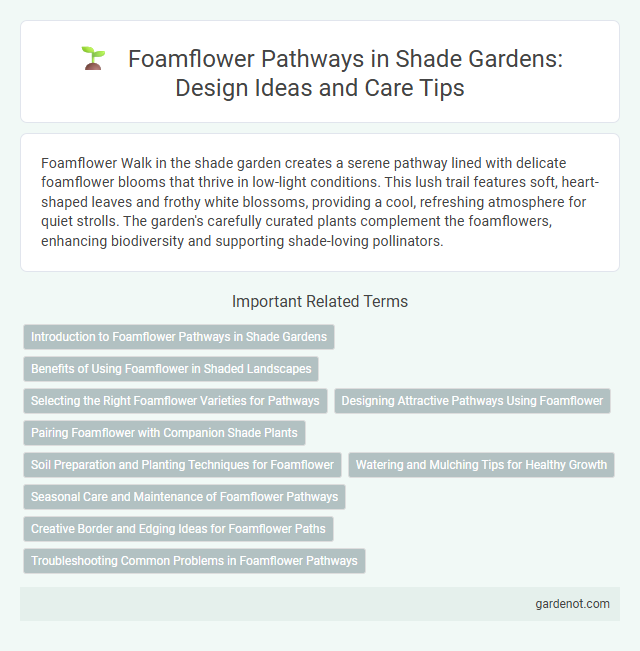Foamflower Walk in the shade garden creates a serene pathway lined with delicate foamflower blooms that thrive in low-light conditions. This lush trail features soft, heart-shaped leaves and frothy white blossoms, providing a cool, refreshing atmosphere for quiet strolls. The garden's carefully curated plants complement the foamflowers, enhancing biodiversity and supporting shade-loving pollinators.
Introduction to Foamflower Pathways in Shade Gardens
Foamflower pathways create enchanting, low-maintenance trails in shade gardens, featuring Tiarella cordifolia's delicate, foamy white blossoms and attractive, lobed foliage. These plants thrive in moist, well-drained, acidic soils under deciduous tree canopies, providing textured ground cover that suppresses weeds and supports biodiversity. Incorporating foamflower pathways enhances garden aesthetics and promotes a natural, woodland atmosphere ideal for shaded landscapes.
Benefits of Using Foamflower in Shaded Landscapes
Foamflower (Tiarella cordifolia) thrives in shaded landscapes, providing dense ground cover that suppresses weeds while enhancing soil moisture retention. Its delicate, foamy white blooms attract pollinators such as bees and butterflies, promoting biodiversity in low-light garden areas. Foamflower's adaptability to various soil types and minimal maintenance needs make it an ideal choice for sustainable, attractive shade gardens.
Selecting the Right Foamflower Varieties for Pathways
Foamflower varieties such as Tiarella cordifolia and Tiarella wherryi offer excellent ground cover for shade garden pathways due to their attractive foliage and delicate blooms. Selecting cultivars with robust growth habits and tolerance for moist, well-drained soil ensures durability and year-round interest in shaded environments. Varieties like 'Running Tapestry' and 'Spring Symphony' provide vibrant leaf patterns and varying bloom times, enhancing the visual appeal of foamflower walkways.
Designing Attractive Pathways Using Foamflower
Incorporating Foamflower (Tiarella cordifolia) into shade garden pathways creates visually appealing, low-maintenance walkways with lush, textured foliage and delicate white to pink blooms. Its dense, spreading growth habit stabilizes soil and suppresses weeds, enhancing pathway durability while providing a natural, woodland charm. Selecting Foamflower cultivars with varied leaf patterns enriches the design, making shaded paths both functional and inviting for year-round interest.
Pairing Foamflower with Companion Shade Plants
Pair Foamflower (Tiarella cordifolia) with hostas, ferns, and astilbes to create a lush, textured shade garden that thrives in moist, well-drained soil. The delicate white or pink blooms of Foamflower contrast beautifully with the broad, variegated leaves of hostas and the feathery fronds of ferns, enhancing visual interest throughout spring and early summer. Selecting companion plants with similar light and moisture requirements ensures a harmonious, low-maintenance garden environment ideal for shaded areas.
Soil Preparation and Planting Techniques for Foamflower
Foamflower thrives in well-drained, humus-rich soil with a slightly acidic to neutral pH between 5.5 and 7.0, making organic matter incorporation essential for optimal growth. Plant foamflower rhizomes in early spring or fall, spacing them about 12 inches apart to allow for healthy colony expansion and ensuring the crown is planted just below the soil surface to prevent rot. Mulching with leaf mold or pine needles maintains soil moisture and acidity, promoting vigorous foliage and delicate white flower spikes.
Watering and Mulching Tips for Healthy Growth
Foamflower thrives in consistently moist soil, so regular watering is essential, especially during dry spells, to prevent the shallow roots from drying out. Applying a 2-3 inch layer of organic mulch such as shredded leaves or pine needles helps retain soil moisture, regulate temperature, and suppress weeds around Foamflower plants. Mulching also promotes a healthy root environment, encouraging vigorous growth and vibrant foliage in shaded garden areas.
Seasonal Care and Maintenance of Foamflower Pathways
Foamflower pathways thrive with seasonal care focused on maintaining soil moisture and mulching to protect roots during colder months. Regular pruning of spent foliage in early spring promotes healthy new growth and keeps the path clear and attractive. Monitoring for pests like slugs and ensuring adequate shade and drainage enhances the longevity and beauty of foamflower walkways.
Creative Border and Edging Ideas for Foamflower Paths
Foamflower paths create a lush, woodland-inspired walkway perfect for shade gardens, where soft, heart-shaped leaves and delicate white blooms add texture and visual interest. Creative border and edging ideas for foamflower paths include using natural materials like moss-covered stones, rustic wooden logs, or low-growing ferns to enhance the organic feel and define the path's shape. Incorporating native shade-loving perennials such as hosta or bleeding heart alongside foamflower can further complement the border, providing layered foliage and seasonal color variations.
Troubleshooting Common Problems in Foamflower Pathways
Foamflower pathways often face issues such as poor drainage leading to root rot and yellowing leaves, which can be resolved by improving soil aeration and adjusting watering schedules. Weed invasion disrupts the delicate balance in foamflower walkways and requires regular mulching and manual removal to maintain healthy growth. Addressing pests like slugs and snails with natural repellents preserves the aesthetic and ecological integrity of shade garden foamflower paths.
Foamflower walk Infographic

 gardenot.com
gardenot.com